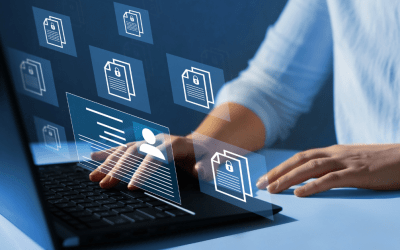What a year it’s been and there’s certainly a lot to learn as we complete year 2 of the dreaded “new normal”. March 2020 marked the start of a drive for enterprise reinvention which has carried on in to 2021. Prior to, some business leaders might have figured it conceivable to coast by for a little while without accepting an advanced change, however the pandemic gave no choice other than to pick up the pace and do it. Some enterprises are now up to seven years ahead of schedule on their digital transformation initiatives according to Mckinsey & Company’s COVID-19 survey. The enterprises that managed to adapt well enough were the ones furthest along their digital transformation journey
Enterprises were forced to move from reasonably well-defined enterprise infrastructures inside office buildings to a wide range of individual remote users signing in from countless access points across the world. Remote work has existed for years along with the cybersecurity measures to safeguard it. The challenge was delivering this protection at unprecedented scale and speed. The number of attacks soared as bad actors targeted the millions of remote workers who didn’t have adequate security protection or sufficient training to be able to spot hacking and phishing attempts.
We have seen a rise in cybersecurity investments due to COVID-19 and its impact with cybersecurity and privacy being included in every business decision along with beefing up security teams. Boards of directors and senior management teams see cyber-risks as the hardest to protect against and the most potentially lethal and damaging to current and future revenue streams. The business case for cybersecurity has become more integral to the success of an enterprise.
-
Trust No One
With the virtual workforce, managing machine identities has become even more critical. With the proliferation of IOT devices, an organisation’s zero trust framework must secure these devices by taking a least-privileged-access approach to prevent malware-based attacks. Zero-Trust took off in 2020 as it became an absolute necessity, we have covered it extensively. Traditional security models operate on the outdated assumption that everything inside an organisation’s network should be trusted, once on the network, users are free to access your data. A Zero Trust model provides security against ransomware and cybersecurity threats by assigning the least required access needed to perform specific tasks. Palo Alto Networks comprehensive IoT Security Solution stands out in the cybersecurity industry as a result of their ability to stay ahead of the curb.
-
Set Boundaries (The New Perimeter)
As mentioned, we have seen an increased emphasis and shift toward zero trust and security access service edge (SASE) principles. This is because virtual workforces make self-diagnosing and self-remediating endpoints a necessity. Endpoint protection platforms must be capable of securely configuring, patching, and managing operating systems and applications. With strong identity & access management capabilities and visibility into remote endpoint devices, security teams can put themselves in position for rapid and effective responses. Quest offers “Unified Endpoint Management” (UEM). UEM allows IT to manage, secure, and deploy corporate resources and applications on any device from a single console. Unified endpoint management is a step beyond traditional mobile device management. UEM includes all use cases and endpoints from mobile to fixed to wearables to IoT through a single comprehensive enterprise mobility management solution.
-
Sharing Is Caring
The fact that cloud systems are exposed to the internet makes them low-hanging fruit for cyber-attackers. Cloud security threats can take on many forms, however, Cloud Misconfiguration is the leading cause of data breaches on the cloud. They open up opportunities for attackers to access password storage and password management systems. Production environments remain the most vulnerable in terms of configuration errors and the lack of visibility into who has access in production environments. Continuous assessment and improvement of cloud security configurations throughout the life cycle of applications and platforms are essential.
Given that cloud services are offered by service providers that handle the hardware and back-end portions of the cloud, it’s easy to assume that they are also responsible for every aspect of security. In reality, that kind of assumption is what has led many organisations into the pitfall of cloud misconfiguration. You can never be too secure, so no matter what kind of setup you employ, you need to adhere to a very important principle of cloud security: shared responsibility. While the service provider offers security for the underlying infrastructure, the organisation is responsible for securing the data itself. It is key to take all of this into consideration when selecting your cloud service provider.
-
The Big Picture
Awareness and education have become even more critical with so many employees now outside the office walls, ironically, insider threats have escalated. It doesn’t have to necessarily start off as a malicious act. Well-meaning employees detached from the corporate office may circumvent controls or best practices just to meet their obligations.. Organisations must have measures, initiatives and touch-points to keep cybersecurity best practices and threats top of mind. Showing team members how breaches occur, helping them recognise risks, and empowering them to be the first line of defence creates a sense of vigilance and responsibility.
Throughout the year, we have emphasised the need for comprehensive and organisation-wide training in order to establish a robust security posture. A sense of responsibility and accountability should be cultivated within the enterprise. However, cybersecurity is a team sport and that collective effort goes beyond the walls of your organisation. We’re all in this together. The cybersecurity community must collaborate and share best practices to form a collective resilience. Throughout 2021, DataGroupIT held numerous webinars with our world leading partners that encourage such team work. Learning from each other will continue to be key going forward.
Lastly, the big picture is about zooming out on your organisation. Cybersecurity is one big risk management project and it is crucial to understand the possible impact of that risk across the organisation. Engaging different parts of the enterprise to prioritise cybersecurity in terms of possible impacts will assist in deploying your resources accordingly and in a way relevant to a particular department as different departments are susceptible to different kinds of risks. This is a team effort in the sense that it should not be left to the IT team alone, risk committees, executives and audit teams must play a role. An organisation’s security posture must be robust at a baseline level, further security efforts may then be applied for specific risk scenarios.
About DataGroutIT
DataGroupIT is Africa’s leading Value-Added Distributor (VAD). By partnering with the best selection of established and emerging technology vendors across the globe, we, provide complex solutions for any size business, including Enterprise and SME markets across the African continent.
Our product portfolio offers comprehensive solutions for IT Security, Infrastructure and Enterprise Software.
We are fully committed to our business partners. Channels & vendors success is our #1 mission. Our professional teams across Africa deliver exceptional sales, presale, logistic, marketing and financial support that create the ultimate platform to accelerate our business partners’ success.
Contact Us today to find out more.




